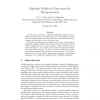524 search results - page 51 / 105 » Disease Modeling Using Evolved Discriminate Function |
MCS
2007
Springer
14 years 4 months ago
2007
Springer
The strength of classifier combination lies either in a suitable averaging over multiple experts/sources or in a beneficial integration of complementary approaches. In this paper...
ACSW
2004
13 years 11 months ago
2004
This paper examines the security aspects of different pervasive scenarios involving agent communities evolved using multi agent systems (MAS). It describes the motivation and the ...
RECOMB
1997
Springer
14 years 2 months ago
1997
Springer
Algorithm development for comparing and aligning biological sequences has, until recently, been based on the SI model of mutational events which assumes that modi cation of sequen...
FAC
2000
13 years 9 months ago
2000
In this paper we present a method of describing microprocessors at different levels of temporal and data abstraction. We consider microprogrammed, pipelined and superscalar proces...
ICSE
2005
IEEE-ACM
14 years 10 months ago
2005
IEEE-ACM
Software systems evolve over time due to changes in requirements, optimization of code, fixes for security and reliability bugs etc. Code churn, which measures the changes made to...

